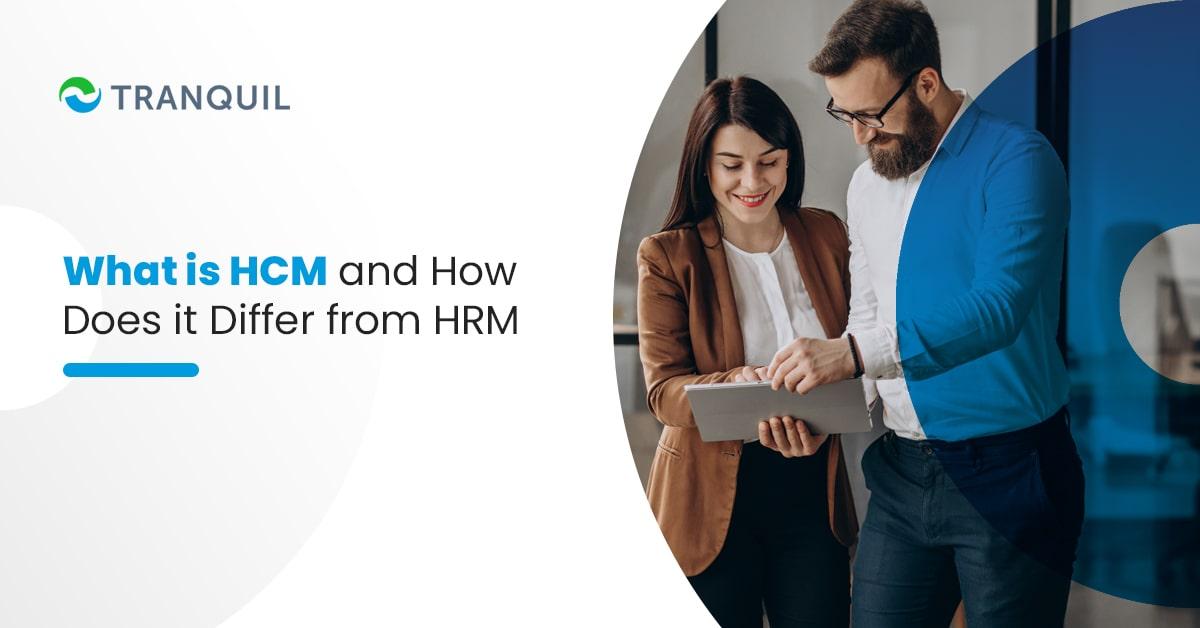
The terms human capital management (HCM) and human resource management (HRM) are often used in place of each other but they are not exactly the same.
It is true that HRM and HCM are very similar and they do have commonalities, but they also differ quite a bit.
To give a very simple explanation, HRM is all about fundamental human resource functions that are administrative in nature, like onboarding, maintaining records, evaluations, ensuring compliance with labor laws, handling payroll, employee benefits, and offboarding employees.
ALSO READ: The Must-Have Modules and Features for an HRMS
HCM however, is a much broader term that includes HRM also, but its main focus is maximizing the value and return on the investment made on employees in n organization.
In other words, HRM places stress on the creation and management of processes and systems that allow employees to perform their jobs effectively, while HCM stress ensuring the maximum economic value of employees to a company.
HRM is the foundation on which HCM function grows.
Let’s delve a little deeper now.
HRM functions ensure that the right person for the right job is hired and that employees are managed efficiently to ensure high productivity.
It facilitates workflow automation and streamlining, and reduces administrative burdens, enabling smooth compliance with regulations – ultimately leading to enhanced productivity, and boosting profitability in the long run.
HRM software is often integrated with ERP software as a module, and includes most of these functions/features:
ALSO READ: Need of Having HR & Payroll Management Software in SMEs?

The conventional HR admin functions like hiring, payroll, talent management, etc., are transformed into opportunities for enhancing productivity, driving engagement, and boosting business value.
Rather than look at employees as a major cost of operating a business, HCM considers the workforce as a fundamental business asset that can be invested in and managed strategically to maximize its value, akin to any other asset.
You can think of it as a cumulative platform of multiple functions designed to promote business growth and stay on top of workforce requirements proactively.
HCM is used to refer to not only the business strategy but also software applications and technologies that help in the implementation of that strategy.
In fact, it is one of the most important technologies that companies can implement to bring about transformation in their business, and HCM is of critical importance in today’s uber-competitive world.
It helps HR professionals to automate and streamline HR processes and empowers employees to perform better.

HCM software includes all processes related to HR and employees in their personnel files; they may include the end-to-end business process of hiring to firing/retiring.
That is, from the time a candidate applies for a job, through the hiring process, onboarding, and application for benefits.
Performance evaluation, feedback, and training are used to develop their skills and improve their performance and contribution to the organization’s success.
ALSO READ: How Does Landed Cost Affect the Cost of Inventory?
HCM software helps to automate this entire process.
While HCM applications automate processes to ease the work of HR departments, they also afford direct access to employees to their HR files.
This helps employees in matters like getting clarity about payroll, applying for benefits, and so on. The software also helps to track organization charts and reporting hierarchies within a company.
Several organizations depend on word-of-mouth knowledge to learn about the organizational structure, to work out hierarchies, and to whom to report.
HCM software can help bring clarity in this regard.

Now that we have got a brief idea of what HCM is, let us examine the benefits of HCM.
Both HRM and HCM have become critical functions for any business, as they have realized that it provides a competitive edge if they can develop and manage their workforce better than other companies.
This is especially true for industries where businesses offer products or services that are very similar to others and have low margins.
Here, a clear distinction can be made with HCM.
ALSO READ: Guide on ERP in Production Planning
It is vital that employees in such companies are committed, engaged, and passionate about their roles, and that they stay in their jobs for long periods.
Processes can be automated to usher in greater efficiency, helping to build strong teams and develop talent that will help in business growth through enhanced efficiency and productivity.
ALSO READ: What is Negative Inventory and How Can you Prevent it?
We have already seen what HRM and HCM are, now let us see how HCM vs HRM stand head-to-head. For that, let us examine the similarities first:
Both applications are about the people in an organization and are solutions driven by data, that can help in crafting innovative workforce strategies and in their effective implementation.
ALSO READ : Ways to Improve the Procurement Process?
The main difference lies in the objective behind the approach of each strategy/software.
While both HRM and HCM play an important part in training, there is a big difference:
HRM takes care of the fundamental HR requirement of small and medium businesses, whereas HCM covers a vast array of functions across the whole lifecycle of employees; it is designed to support the requirements of multinational corporations and large enterprises with regard to payroll and global compliance.
HCM also has sophisticated analytics, cutting-edge data and reporting, and so on.
When you look at recruiting, HCM identifies the employees with the requisite skillset to add value to a company; HRM develops and manages an efficient process for hiring and onboarding that allows businesses to hire the most suitable candidates.
ALSO READ: ERP vs CRM
Both of these software applications are not mutually exclusive; in fact, most organizations enjoy the best performance when the two are combined – especially in the long term.
Strategic corporate goals can be better met when these two strategies and software apps are used in combination or integrated.
Both systems work towards achieving business growth by making employees the primary focus of all HR functions from recruiting through training and compensation, up to retirement or firing, so that they can reach their maximum potential.
ALSO READ: Benefits of ERP for Accounting and Financial Management

There is no doubt that the Covid-19 pandemic has impacted the way businesses function all over the world; it has numerous implications for HR with regard to productivity, managing virtual workforces, swiftly changing talent pool that makes recruitment tougher, fewer women in the workforce, and providing great employee experiences through innovative initiatives.
ALSO READ: How to Manage Your Business from Home in Pandemic Situation?
Look at the challenges your organization is facing, and what are the requirements for growth. You can evaluate this by:
Tranquil ERP is a cloud-based, robust, flexible, and scalable ERP solution with a powerful HR module that can be tweaked to include whatever functionality your business may need. Schedule a demo to see how it works and how it can benefit your business; choose a time and date that is convenient to you. We will be happy to provide detailed explanations and answer all your queries to your satisfaction.